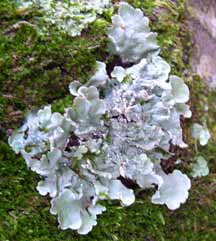

The most common lichens at CWES are shield lichens. They make flat circles on tree trunks and are a pale blue-green color.
|
An Algae Took a "Lichen" to a Fungi
Lichens are found on rocks and trees and often look like peeling paint. When you touch one it often feels dry and flakey. Lichens are an amazing symbiotic (good for both parties) relationship between a fungus and an alga. Fungi include mushrooms, molds, mildews, and rusts. Algae are the tiny, aquatic plants that we see in Minister Lake and can be single or multi-cellular. An alga intertwined with a fungus creates a lichen. The fungus makes up about 60% of the lichen and gives structure and protection to the alga. In turn, the alga photosynthesizes and gives food to the fungus. Lichens grow when they are moist and soak up early morning dew.
How does new lichen form?
There are several ways that a new lichen can be created. If a piece of lichen breaks off and lands in a moist spot, it can begin to grow. Lichens can also send out small packages of algae cells and fungi threads, which can grow into new lichens. The last way is for the fungal part of a lichen to send out tiny spores, which can create a new lichen if they land on an alga.
Did you know? Lichens are very important in creating new habitats, because they can slowly break rock into soil. Lichens are also good for padding bird nests and as food for squirrels, chipmunks, and deer. Lichens are sensitive to air quality and very few can survive in cities.
Learn more: http://ocid.nacse.org/lichenland/html/meeting.html
|
